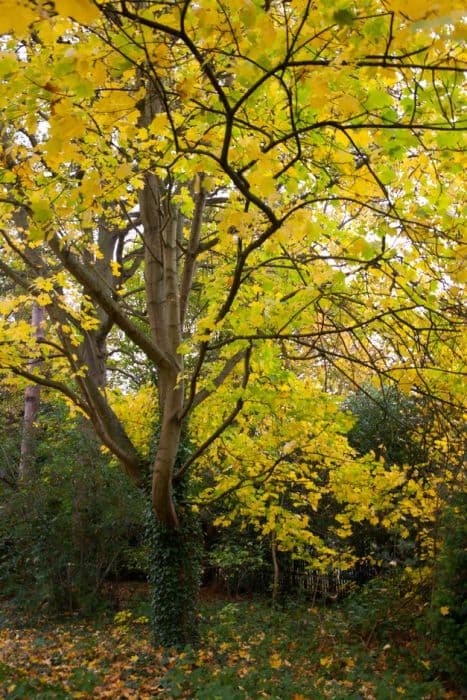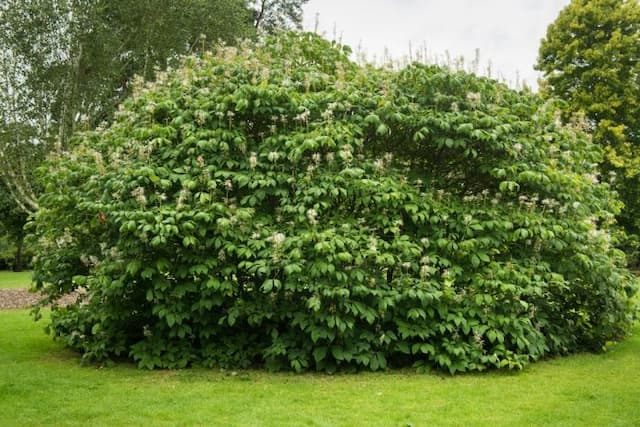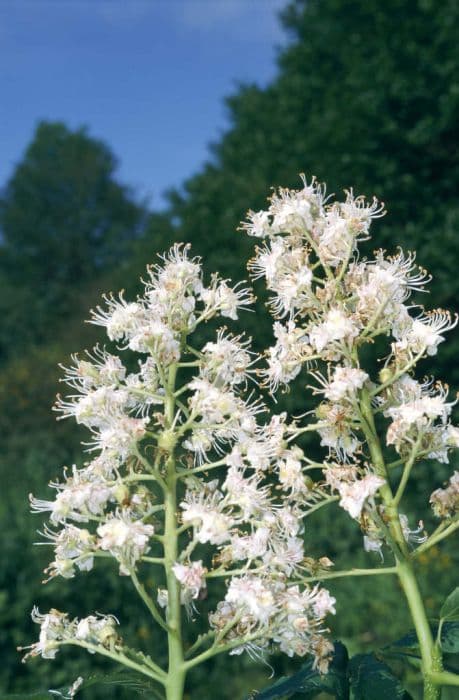Silver maple Acer saccharinum

ABOUT
Acer saccharinum, commonly known as the silver maple, is a species of deciduous tree that is noted for its distinctive leaves and attractive appearance, which make it a favorite in many landscapes. The leaves are a key feature, with a classic maple shape that includes five lobes. The leaves display a green color on the top while the underside is a silvery-white, which is particularly noticeable when the wind blows and the leaves flip and shimmer, creating a beautiful two-toned effect. In spring, the silver maple produces small, red or yellow flowers which add a subtle touch of color to the tree before the leaves fully emerge. As the season progresses into autumn, the leaves transform into a lovely shade of yellow, offering a display of fall color before they drop. Apart from the leaves, the bark of the silver maple is also interesting; it is generally a light gray color and as the tree matures, the bark develops deep furrows and becomes shaggy. It's important to note that the silver maple has a strong and complex root system. The roots can be extensive, spreading widely and sometimes surfacing above ground. This trait, while beneficial for the tree's stability and access to nutrients, can be problematic for nearby structures and pavements. In summary, the silver maple is distinguished by its two-tone leaves, springtime flowers, fall coloration, and furrowed bark, contributing to its popularity as a decorative and shade-providing tree in various settings.
About this plant
 Names
NamesFamily
Sapindaceae.
Synonyms
Silver Maple, Soft Maple, Water Maple, Swamp Maple, Silverleaf Maple, Silver Cutleaf Maple.
Common names
Acer dasycarpum, Acer eriocarpum, Acer saccharinum var. laciniatum, Acer saccharinum var. wieri, Argentacer saccharinum, Saccharodendron saccharinum, Dasycarpum saccharinum.
 Toxicity
ToxicityTo humans
The Silver Maple is generally not considered toxic to humans. While there are no significant toxins present in the Silver Maple that would cause poisoning, it's always prudent to avoid ingesting parts of ornamental plants. Eating large quantities of any plant could potentially cause discomfort or an adverse reaction due to the plant matter itself rather than specific toxins.
To pets
The Silver Maple is not known to be toxic to pets either. However, similarly to humans, it's advisable to prevent pets from chewing on or ingesting parts of this tree to avoid any potential gastrointestinal upset or blockage that could result from the physical plant material, rather than from a specific poison.
 Characteristics
CharacteristicsLife cycle
Perennials
Foliage type
Deciduous
Color of leaves
Green
Flower color
Yellow
Height
50-80 feet (15-24 meters)
Spread
40-70 feet (12-21 meters)
Plant type
Tree
Hardiness zones
3-9
Native area
North America
Benefits
 General Benefits
General Benefits- Aesthetic appeal: Acer saccharinum, commonly known as Silver Maple, is known for its attractive foliage, which adds visual interest to landscapes with its shimmering silver undersides.
- Shade provision: The Silver Maple's broad canopy provides ample shade, which can help reduce cooling costs in nearby buildings during the hot summer months.
- Habitat for wildlife: The tree offers shelter and nesting sites for various bird species, while its seeds serve as food for squirrels and other small mammals.
- Erosion control: The Silver Maple's extensive root system can help stabilize soil and control erosion along riverbanks and in other areas.
- Fast growth: Silver Maple grows rapidly, which can be advantageous for creating quick cover or for reforesting areas in need of vegetation.
- Adaptability: This species is highly adaptable to a range of soil types and urban conditions, making it a resilient choice for city planting.
- Seasonal interest: The Silver Maple provides seasonal interest with its striking fall colors, ranging from deep yellows to reds.
 Medical Properties
Medical PropertiesThis plant is not used for medical purposes.
 Air-purifying Qualities
Air-purifying QualitiesThis plant is not specifically known for air purifying qualities.
 Other Uses
Other Uses- Silver maple's wood is often used in furniture making, providing material for items such as cabinets and flooring due to its moderate hardness and attractive grain patterns.
- The sap of the silver maple can be tapped for syrup making, although it's not as commonly used as the sugar maple, its product is still quite sweet.
- The tree's abundant seeds are sometimes used for crafts or as a food source for wildlife in garden settings, promoting biodiversity.
- Because of their rapid growth and dense foliage, silver maples are used for quick shade in landscapes, parks, and along streets.
- The wood shavings and sawdust from silver maples can be utilized as mulch or as a component in compost piles, contributing to soil health.
- Young silver maple twigs and branches can be woven into baskets and other decorative objects, showcasing the tree's cultural crafting potential.
- Due to its large size and dense canopy, silver maple is often planted as a windbreak on rural properties to shield buildings and soil from strong winds.
- The hollow trunks of older silver maples can provide habitats for various wildlife, including birds and small mammals, when left standing.
- Artisanal woodworkers may use silver maple burls (abnormal growths) and figured wood for creating unique and decorative pieces.
- In riparian restoration projects, silver maples are planted to stabilize stream banks and prevent erosion with their expansive root systems.
Interesting Facts
 Feng Shui
Feng ShuiThe Silver Maple is not used in Feng Shui practice.
 Zodiac Sign Compitability
Zodiac Sign CompitabilityThe Silver Maple is not used in astrology practice.
 Plant Symbolism
Plant Symbolism- Strength and Endurance: The Acer saccharinum, commonly known as the Silver Maple, is known for its strength and ability to withstand harsh conditions, symbolizing the ability to endure life's challenges.
- Adaptability: As a species that's known for growing quickly in a variety of soil types and conditions, the Silver Maple represents adaptability and resilience in various environments.
- Growth: The fast-growing nature of the Silver Maple symbolizes rapid growth and expansion, whether it be in personal life, career, or spiritual journeys.
- Balance: With its contrasting silver underleaf to the green top, the Silver Maple represents the concept of balance and duality in life, reminding us of the importance of harmony between different aspects of our existence.
- Beauty in Impermanence: The Silver Maple's seeds, with their delicate, wing-like structure, can travel far from the parent tree. This symbolizes the transient nature of beauty and life, constantly in motion and ever-changing.
 Water
WaterThe Silver Maple should be watered deeply once or twice a week, depending on weather conditions and soil type, providing about 1.5 to 3 gallons per session for younger trees. Mature trees typically require less frequent watering since they have extensive root systems that can reach deeper moisture reserves. During hot, dry periods, increase the frequency of watering. It's important to avoid overwatering as it can lead to root rot. Aim to keep the soil moist, but not waterlogged.
 Light
LightSilver Maples thrive best in full sun to partial shade, meaning they need at least 4 hours of direct sunlight each day, but they can also tolerate light filtered through other foliage. The best spot for planting a Silver Maple is an area that receives morning sun and afternoon shade, especially in hotter climates, to protect it from the intense heat.
 Temperature
TemperatureSilver Maples are hardy and can withstand a wide temperature range, with a preferred climate between 60-75 degrees Fahrenheit, but they can survive in temperatures as low as -40 degrees and as high as over 100 degrees Fahrenheit. They are resilient through various climate conditions, ensuring their adaptability across many regions.
 Pruning
PruningPrune Silver Maples during the dormant season to remove dead, diseased, or crossing branches and to maintain a strong structure. Light pruning can be done in late winter or early spring before new leaves emerge. Pruning is typically done on an as-needed basis, but it's best to limit major pruning to every 3-5 years to minimize stress on the tree.
 Cleaning
CleaningNot needed.
 Soil
SoilThe best soil mix for Silver Maple (Acer saccharinum) is a well-draining, loamy soil. It should be rich in organic matter to provide nutrients and support root growth. A mixture of garden soil, compost, and either sand or perlite to aid in drainage works well. The soil pH should be between 5.5 and 7.3 to accommodate the Silver Maple's tolerance for slightly acidic to neutral soil conditions.
 Repotting
RepottingSilver Maples (Acer saccharinum) are large trees and are typically not repotted as they are planted outdoors. However, if grown as a young tree or in a container, repotting should be done every 3-5 years or when the tree becomes pot-bound.
 Humidity & Misting
Humidity & MistingSilver Maple (Acer saccharinum) tolerates a wide range of humidity levels and does not require any specific humidity conditions. These trees are adaptable to the outside environment where humidity is naturally regulated.
 Suitable locations
Suitable locationsIndoor
Not suitable to grow indoors due to Silver Maple's size.
Outdoor
Plant in full sun to partial shade; water deeply and infrequently.
Hardiness zone
3-9 USDA
 Life cycle
Life cycleThe life of a Silver Maple (Acer saccharinum) begins with seed dispersal in spring, when the tree’s samaras, or 'helicopter seeds', are carried by the wind to suitable germination sites. Upon landing in moist, fertile soil, the seed germinates and a seedling emerges, typically in early summer, relying initially on the seed's stored resources before photosynthesis begins. The seedling grows into a sapling, with rapid growth in height and the development of a sturdy root system over the next several years. As the Silver Maple matures, it develops a broad, rounded crown with extensive branching, usually reaching reproductive maturity after 11 years. Annually, the tree undergoes a cycle of flowering in early spring before the leaves unfold, followed by pollination (primarily by wind), and subsequent seed development. The mature Silver Maple can live for many decades, or even centuries, continuously reproducing through seed while facing environmental challenges such as varying climate conditions, pests, and diseases until the end of its life cycle.
 Propogation
PropogationPropogation time
Late Winter to Early Spring
Propogation: The most popular method of propagating the Acer saccharinum, commonly known as the Silver Maple, is through seed collection and sowing. The best time to collect seeds is when they mature in late spring or early summer. Once collected, the seeds can be sown immediately or stored in a cool, dry place until the next planting season. The seeds should be planted in well-drained soil and covered with a thin layer of soil, approximately 1/4 inch (about 6 mm) deep. Germination usually occurs within a few weeks, provided the seeds receive adequate moisture and the temperatures are conducive. It is important to note that Silver Maples grow rapidly and can reach large sizes, so they should be sown in an area where they will have ample room to expand.









